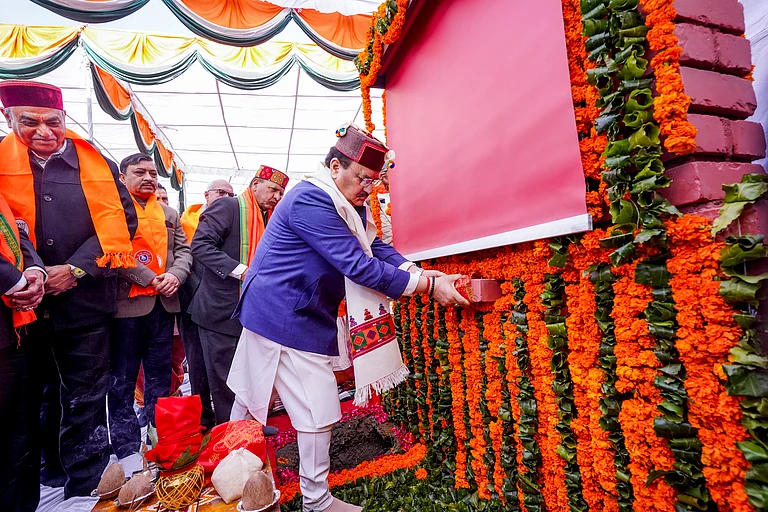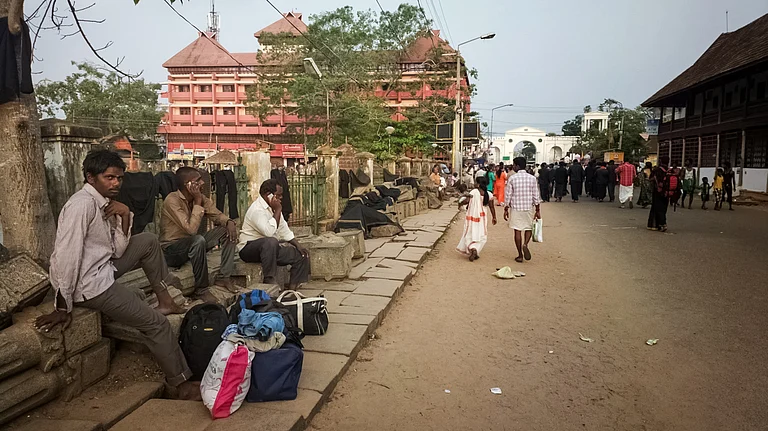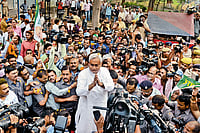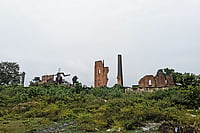
Despite a population of 22 lakh Adivasis in Bihar, mainstream parties have fielded very few tribal candidates, focusing largely on just two reserved seats and sidelining communities even in constituencies with significant Adivasi voters.
Socio-economic indicators show deep marginalisation: over 42 per cent of ST families earn ₹6,000 or less per month, only 1.37 per cent hold government jobs, and just a quarter live in pucca homes.
Independent and lesser-known party candidates from ST communities are contesting this election with limited resources, hoping to reclaim the political relevance and representation that have been long denied to them.
Every morning at eight, 42-year-old Chandlal Oraon sets out with around 150 fellow Adivasis, walking from village to village until evening. They carry with them cooked vegetables and puffed rice, their day’s meal packed before the campaigning begins.
“We mostly walk, and sometimes ride bicycles or bikes if the village is far,” Chandlal says.
There is a motive behind their arduous daily routine.
A member of the Scheduled Tribes, Chandlal is among a handful of Adivasi candidates contesting Bihar’s assembly elections this year. Out of 3,955 candidates in the fray, few are tribals. Chandlal has filed his nomination as an independent candidate from the Dhamdaha assembly constituency in Purnia district, running a campaign on little more than belief, community support and borrowed resources.
Dhamdaha has around 40,000 Adivasi voters, but no mainstream party has fielded an Adivasi candidate from this seat. “Getting a ticket from a mainstream party needs a lot of money,” he says. “Which I don’t have, so I decided to fight the elections as an independent.”
Chandlal is a farmer who also runs a grocery shop. According to his affidavit filed with the Election Commission of India (ECI), he owns one acre of land, a motorcycle, and has one lakh rupees in cash, as well as Rs. 10,000 in his bank account. “I have no money, so I am asking for donations from my community and spending it on campaigning,” he says.
Chandlal decided to contest the assembly elections after Adivasis in his area urged him to. “Non-Adivasi leaders win this seat, but after that, they never visit Adivasi areas, nor do they listen to the issues of tribals. That is why Adivasis wanted me to fight the elections.” He is confident of his chances. “I am getting immense support from people,” he insists.
The Dhamdaha assembly seat is currently held by Janata Dal (United) leader Leshi Singh, a member of the upper caste. For this election, JD(U) has again fielded Leshi Singh, while the Rashtriya Janata Dal (RJD) has given a ticket to Santosh Kumar, and the Jan Suraaj Party (JSP) has fielded Rakesh Kumar. The All India Majlis-e-Ittehadul Muslimeen (AIMIM) candidate is Md. Ishtiyaque Alam.
Mainstream political parties JD(U) and RJD have invited tribal leaders from Jharkhand to campaign in Dhamdaha in an effort to attract Adivasi voters. Reacting to this, Chandlal Oraon says, “What an irony! Mainstream parties are bringing big Adivasi leaders to campaign here to woo Adivasi voters for their candidates, but they didn’t give a ticket to an Adivasi.”
From 2.2 million Adivasis to…
Before the creation of Jharkhand, Bihar had a substantial Adivasi population. In 2000, the state was divided, and the overwhelming majority of its Adivasis became part of the newly carved state of Jharkhand.
In Jharkhand, tribals make up 26 per cent of the total population and are electorally influential, but in Bihar, they remain on the margins, as their numbers do not make them electorally significant.
Currently, Bihar has an Adivasi population of 22 lakh, accounting for approximately 1.68 per cent of the state’s total population. There are 32 recognised tribes in Bihar, including Santhal, Gond, Kharwar, Tharu and Oraon. The Santhal population is around 5.76 lakh, the Gond population is 5.28 lakh, and the Kharwar, with 2.57 lakh people, is the third largest among Scheduled Tribes.
Scheduled Tribes remain at the bottom of social and economic indicators. Data from the Caste Survey shows that 42.70 per cent of the 4.70 lakh ST families are poor and survive on a monthly income of Rs. 6,000 or less.
Very few are employed in government jobs. According to the data, only 1.37 per cent of the total ST population works in the government sector and just 0.68 per cent are employed in the organised private sector. About 18.51 per cent of the total ST population works as labourers.
Data further show that only 25.81 per cent of ST families live in pucca houses, the lowest proportion after the Scheduled Castes.
Adivasis are scattered across more than half a dozen districts. According to government data, tribals form a majority in only about 180 of Bihar’s over 45,000 villages.
Before the division of Bihar, there were 28 assembly seats reserved for Scheduled Tribes out of a total of 324 seats, which was about 8.6 per cent of the total. After Jharkhand was created, these seats were allocated to the new state, and Bihar had no seats reserved for Scheduled Tribes until the Delimitation Commission in 2008 reserved only two assembly seats – Katoria in Banka district and Manihari in Katihar district.
In the 2020 assembly elections, Manohar Prasad Singh of the Congress won the Manihari seat, while Nikki Hembram of the Bharatiya Janata Party (BJP) won the Katoria seat.
This time, the BJP has fielded Puran Lal Tudu from Katoria, while the RJD has given a ticket to Sweety Sima Hembram, who stood second in the last election. Salomi Murmu is contesting from Prashant Kishor’s political start-up, the Jan Suraaj Party. In Manihari, the JD(U) has given a ticket to Shambhu Kumar Suman, and in the Mahagathbandhan, the seat has been reassigned to the Congress, which has reposed its faith in Manohar Prasad Singh. The Jan Suraaj Party has fielded Bablu Soren.
The Constitution of India directs that seat reservation should be proportional to the population. Section (3) of Article 332 of the Constitution states, “The number of seats reserved for the Scheduled Castes or the Scheduled Tribes in the Legislative Assembly of any State under clause (1) shall bear, as nearly as may be, the same proportion to the total number of seats in the Assembly as the population of the Scheduled Castes in the State or of the Scheduled Tribes in the State or part of the State, as the case may be, in respect of which seats are so reserved, bears to the total population of the State.”
According to the 2011 Census, Adivasis comprise 1.28 per cent of Bihar’s population, which means there should be at least four seats reserved for Scheduled Tribes if the constitutional provision is followed.
Ironically, mainstream political parties focus only on the two ST-reserved seats. Beyond these, they rarely field Adivasi candidates, even in general constituencies with a substantial Adivasi population. In contrast, political parties go beyond reserved seats in the case of the Scheduled Castes. Out of 243 seats in Bihar, 38 are reserved for the Scheduled Castes, but both alliances have fielded more SC candidates. The Mahagathbandhan, led by the RJD and Congress, gave 41 tickets to SC leaders, while the National Democratic Alliance (NDA) fielded 39 SC candidates.
Tallu Baski, a member of the newly formed Bihar Scheduled Tribes Commission, says, “There are 40 to 50 seats where Adivasi voters are around 10,000 and at least six to seven seats where Adivasis make up 40,000 to 45,000 of the total voters, but we have only two reserved seats.”
Eternally on the Margins
Data shows that Scheduled Tribes have historically been on the margins in Bihar. In 1962, around 1.3 per cent of the total Members of the Legislative Assembly (MLAs) were from ST communities, a figure that fell to 0.2 per cent in 2020.
Pushpendra, a former professor of social work at the Tata Institute of Social Sciences (TISS), says there are several reasons for their continued marginalisation. “When Bihar was undivided, they were in focus to some extent, but after Jharkhand was created, the remaining Adivasis of Bihar vanished from the collective memory of people, as many think that all Adivasis went to Jharkhand. The second reason is that they are few in number, just 1.68 per cent, so numerically they are not decisive.”
“And the third reason is that, unlike the Extremely Backward Classes (EBC) and SCs, they cannot align themselves with other caste groups to show numerical strength, as they are culturally exclusive,” Pushpendra says.
There is no prominent Adivasi leader in Bihar despite the two reserved seats. ST MLAs rarely attract public or media attention. “If there had been any prominent ST leader or intellectual, they would have raised the issues of Adivasis and pressed for their political identity,” he says.
In a majority-based political system, numbers decide importance. Groups with large populations are prioritised by political parties. Since the Backwards Class (OBC), EBC and SC communities make up double-digit proportions of the population, political parties focus on them in ticket distribution, while Adivasis are overlooked. Pushpendra says, “When number-based politics becomes important, small groups are at a loss, as they are electorally not important. And this is insensitivity.”
Despite being sidelined in political discourse, some Adivasis are trying to break the glass ceiling. Sunil Murmu, 34, who holds a Master’s degree in Hindi, decided to contest the assembly election from Balrampur in Katihar. He runs a coaching centre in his area and was given a ticket by the Bharat Jago Janata Party, a relatively unknown political organisation. However, his nomination was rejected after he left a few columns blank in the form. “I wanted to fight the elections because there is a huge scarcity of good people. Non-Adivasi leaders don’t understand Adivasi issues and don’t provide solutions. There are 15,000 Adivasi voters in the Balrampur assembly. They are facing many issues such as poverty, unemployment and migration,” he says.
Fifty-year-old Sosana Murmu, a school dropout, is contesting as an independent candidate from the Chakai assembly seat in Jamui district, which borders Jharkhand. No Adivasi has won this seat since Lakhan Murmu, who won in the 1962 assembly elections. “We have no money, so we are visiting Adivasi villages and asking for rice and Rs. 5 to spend on campaigning,” she says. “We are facing many issues, but no one listens to us, so we want our own people in the assembly to raise our issues,” Murmu adds.




























